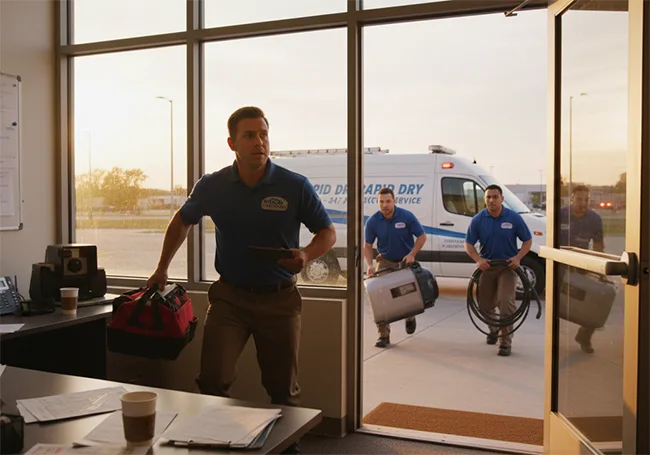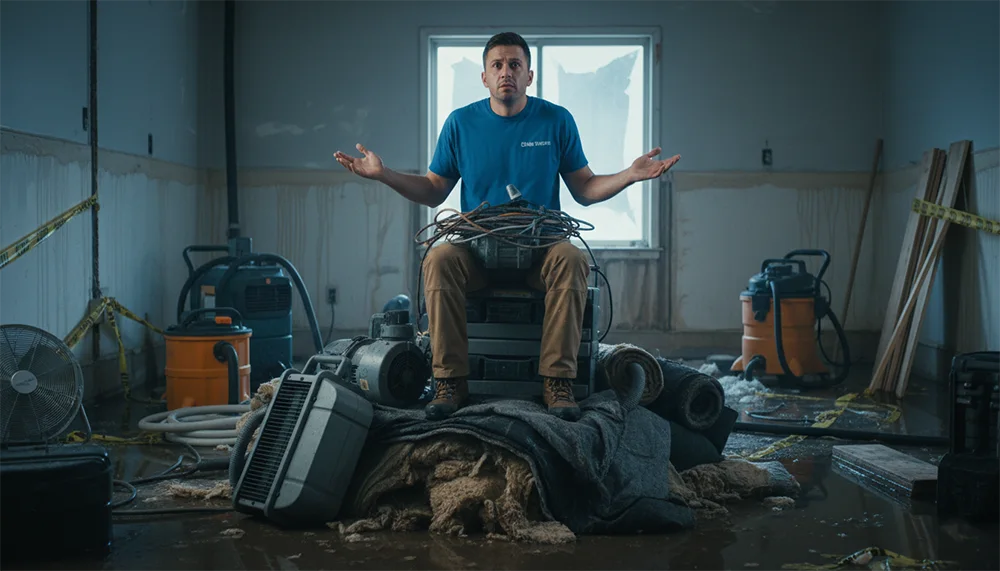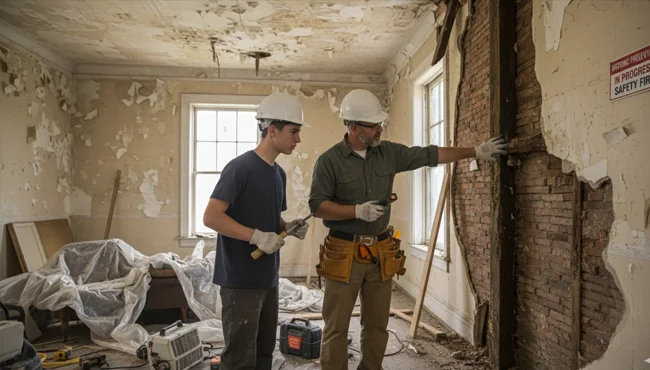The Wall Every Owner Hits
You’re handling $250,000, maybe even $500,000 in revenue, but you’ve hit a wall. Every new job adds more stress, not more profit. You are the chief estimator, the main project manager, the primary customer service rep, and the after-hours dispatcher. You’re trading revenue for personal time, and that is a failing formula.
The problem isn’t a lack of effort. It’s a lack of systematic scale. The strategies that got you to $250K won’t get you to $1 Million and beyond. This is where you need to stop working in the chaos and start building the foundation that allows you to work on your business. This is the Restoration Success Blueprint in action, focusing on the systems that unlock true seven-figure growth.
2. The Great Divide: Why Most Companies Stall at $250K
Most restoration businesses stall because they fail to make a crucial leap: transitioning from a business dependent on the owner’s individual effort to a systemized entity that runs without them.
According to the industry structure overview, companies in Stage 2 ($100K-$250K) start making this transition, moving the owner out of the field and into management. However, many owners get trapped here, believing they are the only ones who can execute the estimate, talk to the adjuster, or handle the difficult client.
This trap is characterized by:
- Manual Processes: Relying on handwritten notes, sticky-note scheduling, and delayed, basic invoicing.
- Lack of Delegation: Holding onto all major decisions and fieldwork, leading to burnout.
- Inconsistent Quality: Since every job relies on the owner’s immediate bandwidth, service quality fluctuates wildly as volume increases.
To begin scaling a restoration business, you must replace yourself with proven systems. That’s the entire point of the shift to Stage 3 ($500K-$1 Million+), where you bring in dedicated office management and Project Managers/Estimators. This delegation is not a luxury; it is the engine of growth.
The Foundation for Growth: Shifting from Technician to CEO
Your first and most difficult job in scaling a restoration business is recognizing that you are no longer a technician—you are a CEO. Your primary responsibilities are now strategy, finance, and system design, not holding the moisture meter.
The Power of the Process Checklist
To delegate effectively, you need a process that is repeatable and teachable. This is why a highly detailed, non-negotiable checklist is paramount. Consider the 99-Step Blueprint—it’s not just a suggestion; it’s a litigation-proof, customer-satisfaction-focused map for every job.
By defining every step, from the initial phone ring to the final collection, you reduce human error and guarantee consistent, high-quality service. This is a powerful element of building Authority and Trust (the core of the TACT framework). When your crew knows the exact checklist for what should be in the truck and what paperwork to execute (like a proper Work Authorization or Moisture Log), you don’t have to micromanage them. The system manages the job, freeing you to focus on strategy.
Standardized Documentation as a Growth Tool
Many small businesses use generic or incomplete paperwork. This low-quality documentation instantly erodes your Trust Score with adjusters and homeowners. To scale, your documents must be standardized and professional. Using robust, attorney-reviewed agreements like the Reconstruction Agreement or detailed Tick Sheets and Moisture Logs signals expertise.
This level of documentation is critical for getting paid by the big carriers like State Farm and Allstate. As the knowledge base notes, these carriers are the easiest to get paid from because they follow the same process every time. If your documents fit their predictable system, payment friction drops dramatically, unlocking cash flow needed for scaling.
Architecting Your Digital Dominance (TACT and SVAC)
Scaling a restoration business today is impossible without a robust digital strategy. Your online presence is not just a brochure; it is your 24/7 digital employee. This is where the Diamond Foundation Blueprint (DFB), guided by TACT (Trust, Authority, Conversion, Traffic) and SVAC (Structure, Visibility, Attraction, Connection), comes into play.
Conversion Over Clicks
Many companies spend thousands on paid traffic, driving clicks to a website that doesn’t convert. This is a waste of capital that prohibits scaling. The DFB focuses on Conversion—making sure your website is structurally sound and immediately builds Trust and Authority.
This means:
- Verifiable Credentials: Utilizing the Restoration Expertise Certification Badge (A, A+, AAA) on your site instantly communicates credibility to a panicked homeowner.
- Clear CTAs: Making it incredibly easy to contact you (the Connection aspect of SVAC).
Structure Before Visibility
The SVAC framework teaches that Structure must precede Visibility. You shouldn’t spend money on SEO or ads until you have a structured, high-converting website foundation.
- Authentic Presence: Your content must sound like a real person talking about real problems—the exact tone we use in the knowledge base and across all content formats. This authenticity builds the Trust that drives Attraction.
- Google 3-Pack Focus: The knowledge base highlights the Google Three-Pack as the “supermodel” of lead generation, especially for water damage jobs coming from plumbers. Scaling requires obsessing over this local SEO ranking, which relies heavily on a high volume of positive customer reviews.
The Path to Stage 4 and Beyond
When you successfully implement the systems, delegate operational tasks, and build a high-converting digital foundation, you cross the $1 Million threshold and enter Stage 4 (Beyond $1M Revenue).
At this level, the focus shifts entirely to:
- Network Benefits: Leveraging your high Trust Score and AAA Certification to build exclusive relationships with insurance adjusters and referral networks.
- Refined Delegation: Creating specialized departments (e.g., dedicated sales/marketing, dedicated production).
- Executive Management: The owner moves into a purely strategic and financial role, working with key managers, not technicians.
This is the point where you achieve true freedom. The business is running, the systems are generating predictable revenue, and your profitability has increased because you are no longer trading your time for dollars.
Which component of your current business structure is the single biggest bottleneck preventing you from implementing a scalable system?
You must view project management as a system, not a personality trait. Start by documenting your entire process into a checklist (e.g., the 99-Step Blueprint). Then, hire a Project Manager whose key performance indicator (KPI) is adherence to that checklist. This removes the reliance on your personal “feel” for the job.
As soon as you hit Stage 2 ($100K revenue) or earlier. Manual scheduling and invoicing are the first things that fail when you try to scale. Software is a system that enforces the standardization needed for growth and is critical before entering Stage 3.
The knowledge base suggests focusing on Captive Agents (e.g., State Farm, Allstate) first. While independents are great, captive agents are part of bigger carriers that are predictable and, honestly, the easiest to get paid from if you know how to fit your documentation into their process. Their predictability is a key element of scalable revenue.
The most critical documents are the Work Authorization and the Reconstruction Agreement. Having clear, professional, and standardized versions of these prevents scope creep, clarifies payment terms, and reduces legal friction, all of which are essential for maintaining high profit margins across high volume.
The biggest danger is burnout and catastrophic operational failure. You are relying entirely on yourself. One bad job, one employee quitting, or one unexpected family emergency can collapse the entire operation because there are no systems or delegated roles to absorb the shock. You’re surviving, not thriving.





